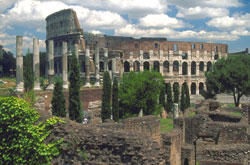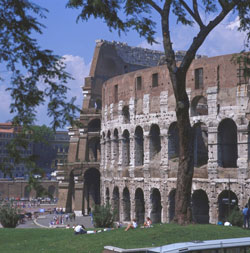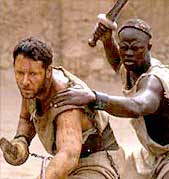|
|
The
Colosseum
 The
Colosseum or Flavian Amphitheater was begun by Vespasian, inaugurated by
Titus in 80 A.D. and completed by Domitian. Located on marshy land between
the Esquiline and Caelian Hills, it was the first permanent amphitheater to
be built in Rome. Its monumental size and grandeur as well as its practical
and efficient organization for producing spectacles and controlling the
large crowds make it one of the great architectural monuments achieved by
the ancient Romans. The
Colosseum or Flavian Amphitheater was begun by Vespasian, inaugurated by
Titus in 80 A.D. and completed by Domitian. Located on marshy land between
the Esquiline and Caelian Hills, it was the first permanent amphitheater to
be built in Rome. Its monumental size and grandeur as well as its practical
and efficient organization for producing spectacles and controlling the
large crowds make it one of the great architectural monuments achieved by
the ancient Romans.
All the Romans liked to go to the theater to watch concert and plays. They
also liked to go to the stadium to watch chariot races and to the
amphitheater to watch sports. Among all these, perhaps going to the
amphitheater i.e. Coliseum was the most popularly accepted by the Romans.
Gladiatorial combats, fights with beasts and other fights were held in the
Coliseum.
 The
amphitheater is a vast ellipse with tiers of seating for 50,000 spectators
around a central elliptical arena. Below the wooden arena floor, there was a
complex set of rooms and passageways for wild beasts and other provisions
for staging the spectacles. Eighty walls radiate from the arena and support
vaults for passageways, stairways and the tiers of seats. At the outer edge
circumferential arcades link each level and the stairways between levels. The
amphitheater is a vast ellipse with tiers of seating for 50,000 spectators
around a central elliptical arena. Below the wooden arena floor, there was a
complex set of rooms and passageways for wild beasts and other provisions
for staging the spectacles. Eighty walls radiate from the arena and support
vaults for passageways, stairways and the tiers of seats. At the outer edge
circumferential arcades link each level and the stairways between levels.
The three tiers of arcades are faced by three-quarter columns and
entablatures, Doric in the first story, Ionic in the second, and Corinthian
in the third. Above them is an attic story with Corinthian pilasters and
small square window openings in alternate bays. At the top brackets and
sockets carry the masts from which the velarium, a canopy for shade, was
suspended.
The construction utilized a careful combination of types: concrete for the
foundations, travertine for the piers and arcades, tufa infill between piers
for the walls of the lower two levels, and brick-faced concrete used for the
upper levels and for most of the vaults.
Coliseum still continues to inspire architects of the modern day, and
virtually every modern sports stadium still bears the irresistible imprint
of the Coliseum's original design. Until the 19th century, it remained the
largest amphitheatre in the world.
Gladiators
 In
ancient Rome, class of professional fighters, who performed for exhibition.
Gladiatorial combats usually took place in amphitheaters. They probably were
introduced from Etruria and originally were funeral games. The gladiators
were paired off to fight each other, usually to the number of about 100
couples, although in the imperial shows there were sometimes as many as
5,000 pairs. There were various types of gladiators, armed and armored
differently. Thus a heavily armored man, a Mirmillo or Samnite, might be
opposed to a Retiarius, who fought almost naked, with a net and a trident as
his only weapons. He also might be pitted against a Thracian, who fought
with a dagger and a small round shield. Often gladiators were made to fight
wild beasts. A defeated gladiator was usually killed by the victor unless
the people expressed their desire that he be spared. At first, gladiators
were invariably slaves or prisoners, including Christians. They normally
underwent rigid training, and some gained immense popularity. Later,
impoverished freedmen also sought a living as gladiators, and finally even
members of the ruling classes took part in gladiatorial combats on an
amateur basis. Constantine I forbade gladiatorial games, but they
nonetheless continued until AD 405. Some gladiators, led by Spartacus , took
part in the third of the Servile Wars. In
ancient Rome, class of professional fighters, who performed for exhibition.
Gladiatorial combats usually took place in amphitheaters. They probably were
introduced from Etruria and originally were funeral games. The gladiators
were paired off to fight each other, usually to the number of about 100
couples, although in the imperial shows there were sometimes as many as
5,000 pairs. There were various types of gladiators, armed and armored
differently. Thus a heavily armored man, a Mirmillo or Samnite, might be
opposed to a Retiarius, who fought almost naked, with a net and a trident as
his only weapons. He also might be pitted against a Thracian, who fought
with a dagger and a small round shield. Often gladiators were made to fight
wild beasts. A defeated gladiator was usually killed by the victor unless
the people expressed their desire that he be spared. At first, gladiators
were invariably slaves or prisoners, including Christians. They normally
underwent rigid training, and some gained immense popularity. Later,
impoverished freedmen also sought a living as gladiators, and finally even
members of the ruling classes took part in gladiatorial combats on an
amateur basis. Constantine I forbade gladiatorial games, but they
nonetheless continued until AD 405. Some gladiators, led by Spartacus , took
part in the third of the Servile Wars.
|
|
 |





